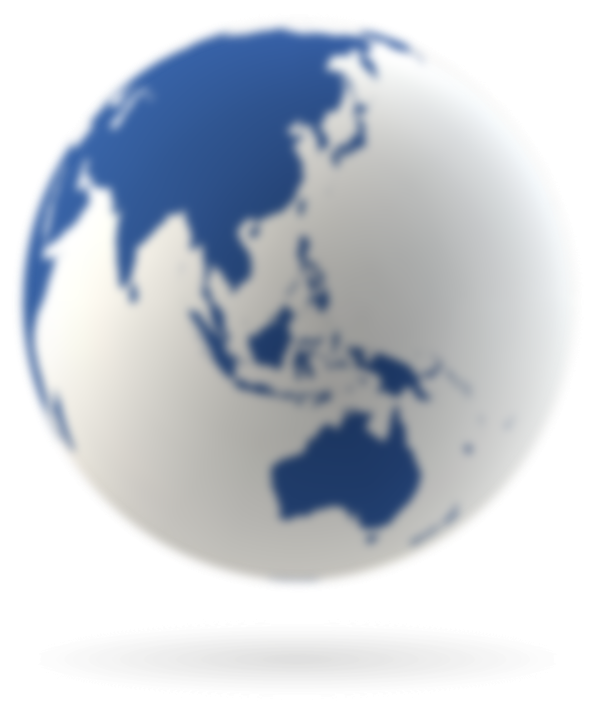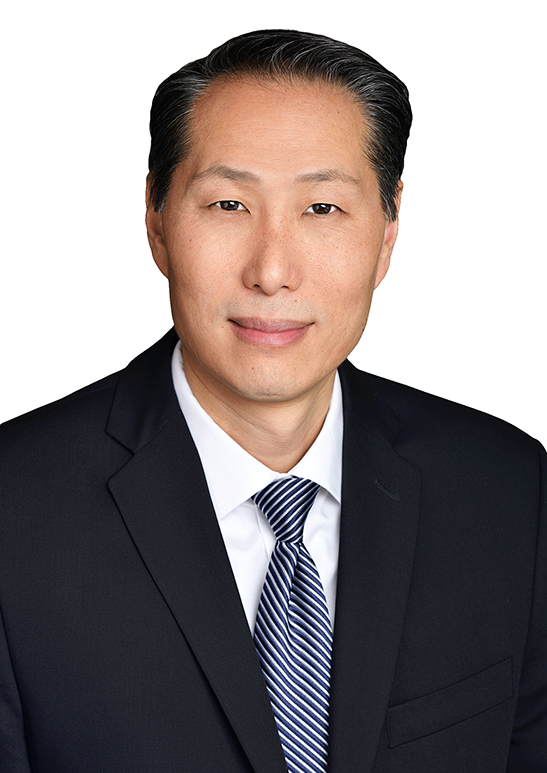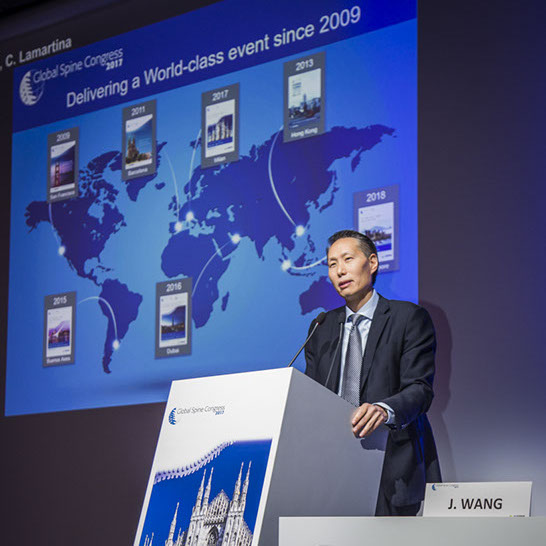feature storY
Global Spine Congress Focus
HIGHLIGHTS
MEET THE AOSPINE MEMBERS


Jeff Wang, Chairperson of the Global Spine Congress, championed a globalized vision that has transformed AOSpine. Here, he discusses the success of the Global Spine Congress and explains why an international view is a key element of his success.
The seventh edition of the Global Spine Congress (GSC) is just around the corner – how has it developed over the years?
It's great when people tell me that they perceive the GSC as a mature meeting. With close to 2000 people attending, the GSC is special as a global academic meeting.
What people are usually less aware of is how it started. When you look at the educational offering from AOSpine previously, it wasn’t really reaching all our members, and it wasn’t something most of our "If someone wants to know about the latest and best international research and hear opinions from international leaders, they’ll find it at the Global Spine Congress. Beyond research, it’s patient management; it’s the hot topics, it’s members-only sessions that give you practical knowledge on day to day things."international members were participating in. We also weren’t as academic back then. A lot of people were sponsored or supported by industry and what we wanted to do was create an academic meeting and help AOSpine grow as an academic society. I think we’ve accomplished that. If someone wants to know about the latest and best international research and hear opinions from international leaders, they’ll find it at the GSC. Beyond research, it’s patient management; it’s the hot topics, it’s members-only sessions that give you practical knowledge on day to day things. It's great to see it growing every year. Now and in the future, we will develop the GSC to infuse the learning and teaching principles of AOSpine, which are among the best in the world.
How did you get involved with the Global Spine Congress?
As Chair of International Education, I felt our educational offering was limited. When we first conceived of this idea of the Global Spine Congress we had had this great vision, but the Board was wary – would people be willing to pay their own registration fee and travel expenses? The Board supported it but felt it might not work. That was like a challenge to us, and if you look at where we are now and how we have evolved, our goals were accomplished. It’s growing every year, and I believe it has transformed AOSpine as an academic society.
How is the GSC different to other big annual spine congresses from around the world?
The main difference is the international attendance and the speakers. Many meetings have some people attending from all over the world, but this meeting is truly international in regards to both speakers and "Many meetings have some people attending from all over the world, but this meeting is truly international in regards to both speakers and participants."participants. Second, a by-product of that is you get opinions and data from all over the world that I don’t think you’d get at the other meetings. We’re catering for the international realm. Wherever we are we look to see how we can cater for an international audience – we want to be the meeting for everyone. Other meetings tend to be based in one region only or focused on one region.
You’ve achieved so much over your career – what are you most
proud of?
Whenever I get involved in an organization, I give 100%. I join because these are missions and people I believe in. The fact I have gone on to become President of some key societies, I think it’s an achievement that they believe in me enough to want me to lead.
I’ve been lucky enough to be elected chairman of AOSpine International, I’m currently the President of The Cervical Spine Research Society, and next year I’ll be President of The North American Spine Society – three major societies I’ve dedicated my time to, and I’m honored to have been elected.

Who has had the most significant influence on your career and who’s been the most inspiring person in your life?
The most inspiring person for me personally was my late father, but in my professional career, Henry Bohlman had a significant influence on me and many other surgeons. Also, Ed Dawson, who developed a spine program at UCLA where I did my training, was a big influence and mentor to me.
Talking of your late father, how has your Chinese background influenced your career?
Coming from China, my parents had to be strong to make it in the US. My father instilled values in me that I have found valuable throughout my entire life. My compassion, my drive, my success, I owe to him. "Whenever you’re in a situation, try to imagine how it affects everyone – not just the people in the room, but your organization, everything. Thinking globally gives a greater perspective and helps you make the right decision."You have to have a strong foundation in this profession. It’s helped me in some of my roles on an international basis because I’m more understanding of other cultures –I’m open to different viewpoints. It’s given me more insight into how other cultures do things, I don’t just come across as being North American, growing up in North America and only having a North American viewpoint, but I’m open to understanding other views and that’s probably one of the things that’sthat have helped me become successful.
What’s the best advice you’ve been given or would give to a young surgeon?
The one piece of advice I repeat a lot in my own mind as well as to other surgeons is to think globally. That advice transcends just the literal meaning. Whenever you’re in a situation, try to imagine how it affects everyone – not just the people in the room, but your organization, everything. Thinking globally gives a greater perspective and helps you make the right decision.
How does a typical workday look like for you?
It varies day to day. Usually, I get into the hospital by 6 am and the first thing we do is round on patients, then we start on cases, and we operate until relatively late. In between cases, I have meetings, emails, and business work to attend to. I work out every night when I get home, no matter what time I get in. I run and lift weights, and I try to play basketball twice a week – that’s a passion of mine.
You’re very active at the AOSpine Knowledge Forums for Degen/Biologics – what interests you about this particular area?
The biological basis of spinal disease and the future cures that are going to revolutionize spine care are in the biological realm. I’ve "I’ve always been interested in spinal biologics because I think that’s the only way to understand how these diseases progress and if we’re going to have some miraculous cure in the future I think it will come from the understanding of biologics."always been interested in spinal biologics because I think that’s the only way to understand how these diseases progress and if we’re going to have some miraculous cure in the future I think it will come from the understanding of biologics. We do a lot of research in other areas, but we call that the Holy Grail – if we can reverse biological disease by regrowing the disc or regenerating the tissue or making the spine young again that’s going to be probably done on a biological basis rather than through an implant.
What developments and breakthroughs do you envision in next
five years?
In the short term, I’d like to see a couple of things. First, the biologics we’re using based on evidence rather than just marketing, because we have to pick the right product based on what works and what doesn’t. We need more evidence. Second, a lot of trials now look at potential growth factors for preventing disc degeneration preventing back pain. A couple of studies we’re participating in look at growth factor injections into the disc and looking at nerve innervation of the disc and end plate to cure pain on biological basis, which would be minimally invasive - you’d get an injection which would help the patient rather that doing a huge invasive surgery.
From your perspective what are the main challenges in your specialty?
One of the biggest challenges right now is there’s not as much funding for research. Also, there are more concerns now for patient safety, which is good, but it does inhibit the innovation process. If you came up with a miracle cure it would take so much time and money to get it approved – the bar is much higher now than in the past.
You’re one of the editor in chiefs of the Global Spine Journal. How has that evolved and grown?
It’s grown in leaps and bounds. Every year we have a record number of submissions and the quality of the research submissions is outstanding. It’s also the platform by which our international members disseminate their research. When you open any issue, you’ll be surprised by the international depth of the research and submissions coming from all the corners of the world.
What does AOSpine mean to you and why would you recommend becoming a member?
First of all, there’s a lot of member benefits – probably more than any other society you’ll find. Not only will you have access to different educational opportunities and publications, you also get access to "When you open any issue of the Global Spine Journal, you’ll be surprised by the international depth of the research and submissions coming from all the corners of the world."publishing your research. AOSpine covers the costs for open access submissions to the Global Spine Journal If you look at our leadership and our Knowledge Forums, we’re international. We’re not based in one single region so whether you’re in some town in a remote area or a big city, you can get involved and make a difference.
Jeff Wang is the Chairperson of the Global Spine Congress, the past Chairperson of the AOSpine Knowledge Forum Degen/Biologics and former Chairperson of AOSpine International.
Jeffrey C. Wang Biography
Jeffrey C. Wang, MD is Professor of Orthopedic Surgery and Neurosurgery, Co-Director of the USC Spine Center with an expertise in the surgical treatment of all neck and back disorders. As a world-renowned leader in spine care, Jeff Wang is continuously writing and presenting professional articles, publications, and speaking engagements to national and international audiences. His reputation for consistently providing excellent patient care, outstanding qualifications and experience has earned him immense respect from patients and physicians alike. He assumes numerous leadership roles in internationally respected medical organizations including AOSpine, the North American Spine Society, Cervical Spine Research Society, the American Academy of Orthopedic Surgeons, and multiple other educational and research groups. In addition, Jeff Wang serves as a Second Medical Opinion Physician with the National Hockey League (NHL) and the National Hockey League Players' Association (NHLPA). In addition to a busy clinical practice, he runs a basic science laboratory where he is on the cutting edge of technology, and constantly developing and applying novel methods of treating spinal disorders. His research interests include gene therapy for the treatment of spinal disorders, minimally invasive surgery for spinal disorders, bone growth biological proteins and biomedical engineering of non-invasive spine surgery using high intensity focused ultrasonic waves. Jeff Wang has received numerous research grants and is currently involved in many clinical trials in the treatment of spine problems.
Jeff Wang
– the global perspective
Newsletter 16 | April 2018
Newsletter 16 April 2018
feature storY
Global Spine Congress Focus
HIGHLIGHTS
MEET THE AOSPINE MEMBERS